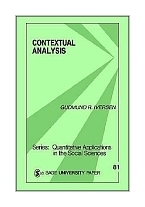|
||
• wydawnictwa polskie
• Zamów informacje o nowościach z wybranego tematu • kontakt
• Cookies na stronie |
CONTEXTUAL ANALYSISIVERSEN G.R.wydawnictwo: SAGE , rok wydania 1991, wydanie Icena netto: Contextual analysis, the study of the role of the group context on actions and attitudes of individuals, is a useful technique in the study of education, neighborhoods, census tracts, election districts, and the family. However, the effective use of contextual analysis has involved overcoming a number of issues, such as group boundaries, the mobility of the individuals within a group, overlapping groups, missing individual data, and the choice of statistical models. Contextual Analysis offers researchers a guide for selecting the best model to use. Written in a straightforward style, the book explores such topics as contextual analysis with absolute effects, with relative effects, and the choice between regression coefficients as fixed parameters or as random variables. Table of ContentsIntroduction 92 pages, Paperback Księgarnia nie działa. Nie odpowiadamy na pytania i nie realizujemy zamówien. Do odwolania !. |


